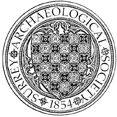31 Lower Church Lane, Farnham
Building works within the standing building, which dates to the late 16th century, revealed a number of features subsequently recorded by D Graham. A small mortar-lined conical pit containing solidified lead was identified, presumably the remains of a furnace associated with lead working. No dating evidence was recovered, but the furnace must pre-date the standing building and appeared to be later than a stone floor, apparently of 13th century date, which was also recorded. From evidence elsewhere in the town, it is thought likely that the furnace dates to the early 16th century (292)


